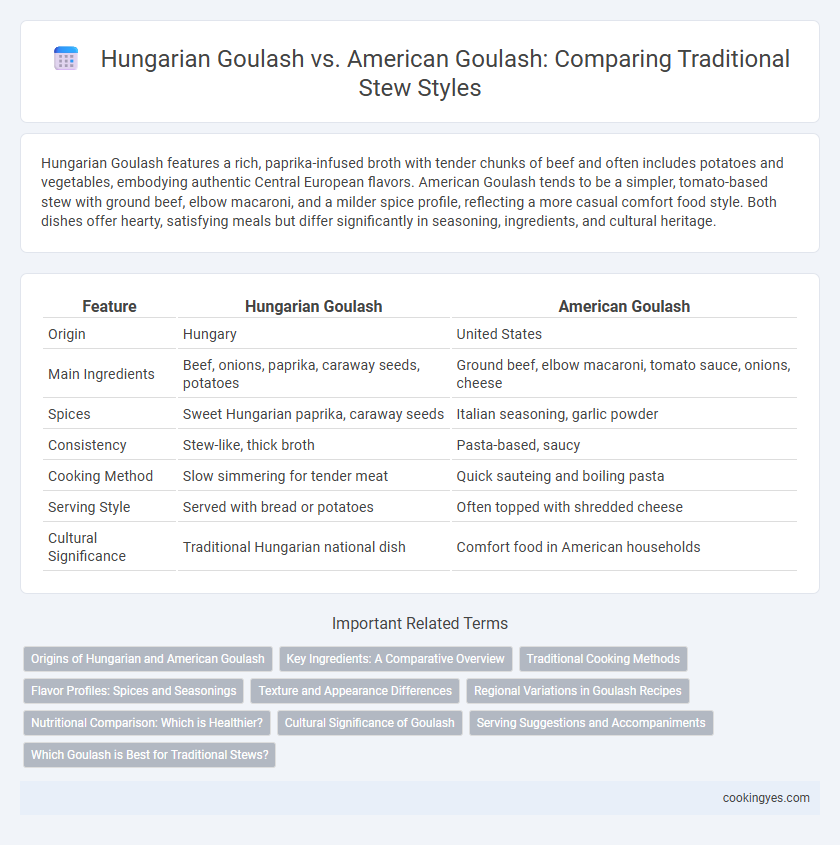Hungarian Goulash features a rich, paprika-infused broth with tender chunks of beef and often includes potatoes and vegetables, embodying authentic Central European flavors. American Goulash tends to be a simpler, tomato-based stew with ground beef, elbow macaroni, and a milder spice profile, reflecting a more casual comfort food style. Both dishes offer hearty, satisfying meals but differ significantly in seasoning, ingredients, and cultural heritage.
Table of Comparison
| Feature | Hungarian Goulash | American Goulash |
|---|---|---|
| Origin | Hungary | United States |
| Main Ingredients | Beef, onions, paprika, caraway seeds, potatoes | Ground beef, elbow macaroni, tomato sauce, onions, cheese |
| Spices | Sweet Hungarian paprika, caraway seeds | Italian seasoning, garlic powder |
| Consistency | Stew-like, thick broth | Pasta-based, saucy |
| Cooking Method | Slow simmering for tender meat | Quick sauteing and boiling pasta |
| Serving Style | Served with bread or potatoes | Often topped with shredded cheese |
| Cultural Significance | Traditional Hungarian national dish | Comfort food in American households |
Origins of Hungarian and American Goulash
Hungarian Goulash, originating in the 9th century from Hungary's pastoral communities, is a traditional stew featuring slow-cooked beef, onions, and paprika, reflecting Central European culinary heritage. American Goulash, often called "American chop suey," emerged in the early 20th century as a simple, affordable pasta and ground beef casserole with tomato sauce, influenced by Italian-American cuisine. The contrasting origins highlight Hungarian Goulash's rich paprika-spiced broth rooted in Hungarian shepherd culture versus American Goulash's quick, one-pot adaptation designed for busy households.
Key Ingredients: A Comparative Overview
Hungarian Goulash features key ingredients such as tender beef, Hungarian paprika, onions, garlic, caraway seeds, and root vegetables like carrots and potatoes, creating a rich and aromatic stew. American Goulash, also known as goulash or American chop suey, typically combines ground beef, elbow macaroni, tomatoes or tomato sauce, onions, and bell peppers, offering a more pasta-forward, tomato-based dish. The fundamental difference lies in Hungarian Goulash's emphasis on paprika-spiced meat stewing versus American Goulash's incorporation of pasta and more simplified, tomato-centric ingredients.
Traditional Cooking Methods
Hungarian goulash traditionally uses slow-cooked beef or veal with paprika, onions, and caraway seeds simmered in a rich broth to develop deep, authentic flavors. American goulash, often a faster one-pot meal, incorporates ground beef, tomatoes, and pasta, deviating from the classic Hungarian stew style. The traditional Hungarian method emphasizes extended simmering to tenderize meat and meld spices, while American recipes prioritize convenience and quicker preparation.
Flavor Profiles: Spices and Seasonings
Hungarian Goulash features paprika as its signature spice, imparting a rich, smoky depth combined with caraway seeds and garlic for an authentic, hearty flavor. American Goulash, often incorporating tomato sauce, ground beef, and milder seasonings like oregano and basil, offers a sweeter, more tomato-forward profile. The distinct use of smoky paprika versus sweeter, herb-based seasonings defines the traditional stew's divergent flavor identities.
Texture and Appearance Differences
Hungarian Goulash features a chunky, stew-like texture with tender beef, vegetables, and a rich paprika-infused broth, giving it a vibrant red color and a rustic, hearty appearance. American Goulash, often called "American chop suey," is a pasta-based dish with ground beef, tomato sauce, and elbow macaroni, resulting in a saucier, softer texture and a more uniform, casserole-like look. The Hungarian version is less dense, emphasizing bold spices and a thicker stew consistency, while the American variant prioritizes ease and comfort food qualities with a smoother, saucier blend.
Regional Variations in Goulash Recipes
Hungarian Goulash features a rich, paprika-spiced beef stew with onions, potatoes, and sometimes caraway seeds, emphasizing a thick, aromatic broth typical of Central European cuisine. American Goulash, often called "American chop suey," incorporates ground beef, elbow macaroni, tomatoes, and mild spices, reflecting Midwestern adaptations aimed at convenience and family-friendly meals. Regional variations highlight Hungary's focus on slow-cooked, robust flavors, while American versions prioritize quick preparation and pasta integration.
Nutritional Comparison: Which is Healthier?
Hungarian Goulash traditionally features lean beef, paprika, onions, and vegetables, making it rich in protein and antioxidants with moderate calories and fat content. American Goulash often contains ground beef, pasta, and tomato sauce, resulting in higher carbohydrate and calorie levels but less emphasis on spices and vegetables. Nutritionally, Hungarian Goulash tends to be healthier due to its balanced macronutrients and nutrient-dense ingredients, while American Goulash may contribute to greater calorie intake and lower micronutrient variety.
Cultural Significance of Goulash
Hungarian Goulash, a symbol of national pride, reflects Hungary's rich heritage through its slow-cooked beef, paprika, and hearty vegetables, serving as a cultural emblem of resilience and tradition. American Goulash, meanwhile, adapts the concept into a comfort food with ground beef, elbow macaroni, and tomato sauce, showcasing a blend of immigrant influences and practical American home-cooking. Both variations highlight how Goulash evolves to represent cultural identity and local tastes while maintaining its roots as a cherished stew.
Serving Suggestions and Accompaniments
Hungarian Goulash, a rich and hearty stew made with tender beef, onions, paprika, and caraway seeds, is traditionally served with buttered egg noodles, crusty bread, or potato dumplings to soak up its flavorful sauce. American Goulash typically features ground beef, elbow macaroni, and a tomato-based sauce, often accompanied by a simple green salad or garlic bread for a quick, comforting meal. Both variations benefit from garnishes like sour cream or fresh parsley to enhance their respective regional flavors and presentation.
Which Goulash is Best for Traditional Stews?
Hungarian goulash features tender beef, paprika, and a rich broth, preserving authentic Central European flavors ideal for traditional stew recipes. American goulash blends ground beef, elbow macaroni, and tomato sauce, creating a hearty, pasta-based meal with a milder spice profile. For traditional stews, Hungarian goulash offers the best authenticity, delivering deep, smoky paprika notes and a robust, stew-like texture.
Hungarian Goulash vs American Goulash for traditional stew Infographic

 cookingyes.com
cookingyes.com